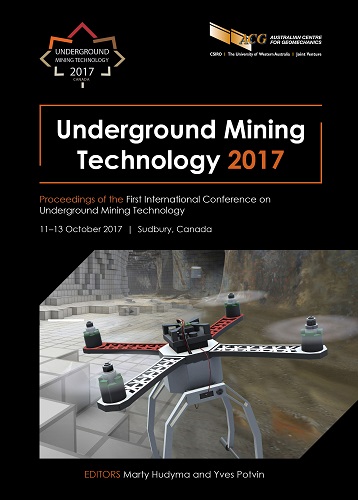Determination of optimum drawpoint layout in block caving using sequential Gaussian simulation

|
Authors: Ugarte, E; Pourrahimian, Y; Boisvert, JB |
DOI https://doi.org/10.36487/ACG_rep/1710_26_Pourrahimian
Cite As:
Ugarte, E, Pourrahimian, Y & Boisvert, JB 2017, 'Determination of optimum drawpoint layout in block caving using sequential Gaussian simulation', in M Hudyma & Y Potvin (eds), UMT 2017: Proceedings of the First International Conference on Underground Mining Technology, Australian Centre for Geomechanics, Perth, pp. 339-349, https://doi.org/10.36487/ACG_rep/1710_26_Pourrahimian
Abstract:
The economics of today’s mining industry are such that the major mining companies are increasing the use of massive mining methods. Caving methods have become the underground bulk mining method of choice and are expected to continue as such in the foreseeable future. Caving methods are favoured because of their low cost and high production rates. They offer a much smaller environmental footprint compared to equivalent open pit operations due to the much smaller volume of waste to be moved and handled. Drawpoint spacing is an essential part of the block cave layout design which must be investigated carefully at the start of the project. In this paper, an overall methodology based on sequential Gaussian simulation (SGS) to obtain the drawpoint spacing is suggested. The optimised drawpoint spacing is used to maximise the profit since the extraction layout is highly essential for the economics of block caving. This study is opening a new horizon for using ‘all realisations all the time’ as a new approach to solve one of the trickiest elements of blocks caving.
Keywords: block caving, drawpoint spacing, layout optimisation, uncertainty
References:
Ahmed, H, Scoble, M & Dunbar, S 2014, ‘A comparison between offset herringbone and El Teniente underground cave mining extraction layouts using a discrete event simulation technique’, International Journal of Mining Reclamation and Environment, vol. 30, no. 2, pp. 1–21.
Botha, J, Watson, S, Arkadius, T & Samosir, E 2008, ‘Simulation applications at PT Freeport Indonesia’s DOZ/ESZ block cave mine’, Proceedings of the 5th International Conference and Exhibition on Mass Mining, Luleå, pp. 237–246.
Castro, R, Vargas, R, & Huerta, F 2012, ‘Determination of drawpoint spacing in panel caving: a case study at El Teniente mine’,
The Journal of the Southern African Institute of Mining and Metallurgy, vol. 112, no. 10, pp. 871–876.
Chitombo, GP 2010, ‘Cave mining: 16 years after Laubscher's 1994 paper ‘Cave mining–state of the art’’, Mining Technology, vol. 119, no. 3, pp. 132–141.
Deutsch, CV & Journel, AG 1998, GSLIB: Geostatistical Software Library and User's Guide, 2nd edn, Oxford University Press, New York.
Deutsch, CV 2015, ‘All realisations all the time’, Proceedings of the CCG 17th Annual Meeting, University of Alberta, Edmonton, paper 2015-101.
Diering, T 2000, ‘PC-BC: A block cave design and draw control system’, in G Chitombo (ed.), Proceedings of MassMin 2000, The Australasian Institute of Mining and Metallurgy, Melbourne, pp. 469–484.
Diering, T 2013, Reserve Estimation Using GEOVIA PCBC, Dassault Systemes Geovia Inc., Vancouver.
Laubscher, DH 1994, ‘Cave mining-the state of the art’, Journal of the South African Institute of Mining and Metallurgy, vol. 94, no. 10, pp. 279–293.
Laubscher, DH 2000, Block Caving Manual, prepared for the International Caving Study, Julius Kruttschnitt Mineral Research Centre and Itasca Consulting Group, Inc., Brisbane.
Leach, A, Naidoo, K & Bartlett, P 2000, ‘Considerations for design of production level drawpoint layouts for a deep block cave’, in G Chitombo (ed.), Proceedings of MassMin 2000, The Australasian Institute of Mining and Metallurgy, Melbourne,
pp. 356–366.
Silva, DA & Deutsch, CV 2012, ‘Modeling multiple rock types with distance functions: methodology and software’, Proceedings of the Centre for Computational Geostatistics 14th Annual Meeting, University of Alberta, Edmonton, paper 2012-307.
© Copyright 2025, Australian Centre for Geomechanics (ACG), The University of Western Australia. All rights reserved.
View copyright/legal information
Please direct any queries or error reports to repository-acg@uwa.edu.au
View copyright/legal information
Please direct any queries or error reports to repository-acg@uwa.edu.au